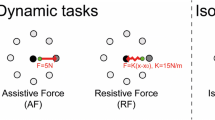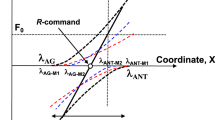Abstract
The activation of muscles can be studied by measuring the activity of a representative set of single motor units in a muscle or by measuring the surface electromyographic (EMG) activity of a muscle that results from the contribution of a large number of motor units. In this study we have developed a model showing how the direction dependence of the amplitude of the EMG activity during isometric contractions can be understood from the recruitment thresholds of single motor units when force is applied in various directions within a plane. The model predicts that the direction with the largest EMG activity (called the “preferred direction”) corresponds to the direction in which the largest number of motor units is recruited. If one assumes homogeneous activation of a population of motor units, this preferred direction can be shown to be equivalent to the direction in which the recruitment threshold of the motor units is smallest. The experimental data show that, for most muscles in the human arm, the amplitude of surface EMG activity for a constant, isometric force at the wrist was proportional to the cosine of the angle between the muscle's preferred direction and the direction of force. As predicted by the model, the preferred direction coincided with the direction in which the recruitment threshold of motor units was smallest. Musculus deltoideus anterior had a more complicated directional sensitivity for surface EMG activity that could not be well fit by a single cosine function. This effect could be explained by the finding of two subpopulations of motor units within that muscle, each with a different recruitment behavior.
Similar content being viewed by others
References
Buchanan TS, Almdale DPJ, Lewis JL, Rymer WZ (1986) Characteristics of synergic relations during isometric contractions of human elbow muscles. J Neurophysiol 56:1225–1241
Buchanan TS, Rovai GP, Rymer WZ (1989) Strategies for muscle activation during isometric torque generation at the human elbow. J Neurophysiol 62:1201–1212
Calancie B, Bawa P (1990) Motor unit recruitment in humans. In: Binder M, Mendell LM (eds) The orderly recruitment of motor units. Oxford University Press, Oxford, pp 75–95
De Luca CJ (1979) Physiology and mathematics of myoelectric signals. IEEE Trans Biomed Eng 26:359–370
De Luca CJ, Leferer RS, McCue MP, Xenakis AP (1982) Behaviour of human motor units in different muscles during linearly varying contractions. J Physiol 359:107–118
Flanders M, Soechting JF (1990) Arm muscle activation for static forces in three-dimensional space. J Neurophysiol 64:1818–1837
Gielen S, Ingen Schenau GJ van, Tax T, Theeuwen M (1990) The activation of mono- and bi-articular muscles in multi-joint movements. In: Winters JM, Woo SLY (eds) Multiple muscle systems: biomechanics and movement organization. Springer, Berlin Heidelberg New York, pp 302–311
Gottlieb GL, Agarwal GC (1971) Dynamic relationship between isometric muscle tension and the electromyogram in man. J Appl Physiol 30:345–351
Gustafsson B, Pinter MJ (1985) On factors determining orderly recruitment of motor units: a role for intrinsic membrane properties. Trends Neurosci 8:431–433
Haar Romeny BM ter, Denier van der Gon JJ, Gielen CCAM (1982) Changes in recruitment order of motor units in the human biceps muscle. Exp Neurol 78:360–368
Haar Romeny BM ter, Denier van der Gon JJ, Gielen CCAM (1984) Relation of the location of a motor unit in human biceps muscle and its critical firing levels for different tasks. Exp Neurol 85:631–650
Henneman E (1981) Recruitment of motoneurons: the size principle. In: Motor unit types, recruitment, and plasticity in health and disease. In: Desmed JE (ed) Progress in clinical neurophysiology, vol 9. Karger, Basel, pp 26–60
Henneman E, Somjen G, Carpenter DO (1965a) Functional significance of cell size in spinal motoneurons. J Neurophysiol 28:581–598
Henneman E, Somjen G, Carpenter DO (1965b) Excitability and inhibitibility of motoneurons of different size. J Neurophysiol 28:599–620
Jongen H (1989) Theories and experiments on muscle coordination during isometric contractions. Thesis, University of Utrecht, The Netherlands
Kukulka CG, Ciamann HP (1981) Comparison of the recruitment and discharge properties of motor units in human brachial biceps and adductor pollicis during isometric contractions Exp Brain Res 219:45–55
Lippold OJC (1952) The relation between integrated action potentials in human muscle and its isometric tension. J Physiol (Lond) 117:492–499
Miller LE, Gielen CCAM, Theeuwen M, Doorenbosch D (1992) The activation of mono-and biarticular muscles in multijoint movements. In: Caminiti R, Johnson PB, Burnod Y (eds) Control of arm movement in space. Neurophysiological and computational approaches. Springer, Berlin Heidelberg New York pp, 1–15
Patla AE, Hudgins BS, Scott RN (1982) Myoelectric signal as a quantitative measure of muscle mechanical output. Med Biol Eng Comput 20:319–328
Person RS, Kudina LP (1972) Discharge frequency and discharge pattern of human motor units during voluntary contraction of muscle. Electroencephalogr Clin Neurophysiol 32:471–483
Riek S, Bawa P (1992) Recruitment of motor units in human forearm extensors. J Neurophysiol 68:100–108
Tax A, Denier van der Gon JJ, Gielen CCAM, Tempel CMM van den (1989) Differences in the activation of m. biceps brachii in the control of slow isotonic movements and isometric contractions Exp Brain Res 76:55–63
Tax AAM, Denier van der Gon JJ, Gielen CCAM, Kleyne M (1990a) Differences in central control of m. biceps brachii in movement tasks and force tasks. Exp Brain Res 79:138–142
Tax AAM, Denier van der Gon JJ, Erkelens CJ (1990b) Differences in coordination of elbow flexor muscles in force tasks and in movement tasks. Exp Brain Res 81:567–572
Zajac FE (1990) Coupling of recruitment order to the force produced by motor units: the “size principle hypothesis” revisited. In: Binder, Mendell (eds) The orderly recruitment of motor units. Oxford University Press, Oxford, pp 96–111
Zuylen EJ van, Gielen CCAM, Denier van der Gon JJ (1988) Coordination and inhomogeneous activation of human arm muscles during isometric torques. J Neurophysiol 60:1523–1548
Author information
Authors and Affiliations
Rights and permissions
About this article
Cite this article
Theeuwen, M., Gielen, C.C.A.M., Miller, L.E. et al. The relation between the direction dependence of electromyographic amplitude and motor unit recruitment thresholds during isometric contractions. Exp Brain Res 98, 488–500 (1994). https://doi.org/10.1007/BF00233986
Received:
Accepted:
Issue Date:
DOI: https://doi.org/10.1007/BF00233986




